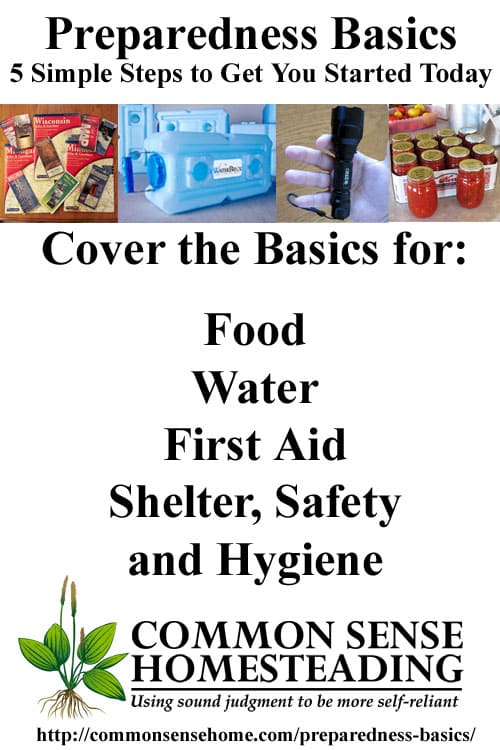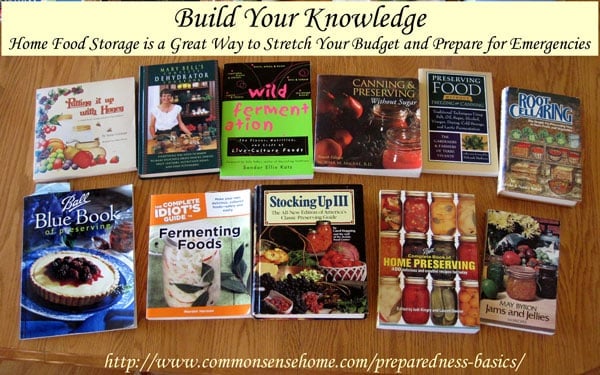Preparedness Basics – 5 Simple Steps to Get You Started Today
This post may contain affiliate links. Read my full disclosure here.
You have that nagging feeling you aren’t prepared – but you don’t know what to do, where to start, or maybe even what to prepare for. Take a deep breath and think what caused you to start thinking about getting prepared. Worrying can wear you out and freeze you into inaction. The best remedy is to take action.

Think through what the real risks are for you. Start with the most likely event first, and prepare for that. In this post we’ll discuss the preparedness basics that everyone should cover.
Some of the most common “Everyday Emergencies”
Job loss and Reduced Income – Businesses restructure, industries change, you change – the average person will hold 11 different jobs during their lifetime. Many companies have reduced full time workers to part time in an effort to reduce costs.
Weather – Hurricanes, blizzards, bitter cold, tornadoes – all of these are likely to present physical risks to your person and your property, as well as the potential for power grid failure and difficult travel.
Minor injuries – From falling on the ice or water slicked surfaces to dog bites and bee stings, accidents happen. Every household should have a basic medical kit on hand for minor injuries.
For more on relative risks, see the post, “Odds of Everyday Emergencies“.
Table of contents
Preparedness Basics – Covering the “Stuff”
To get started we suggest you start with the basics of life:
- Food
- Water
- First Aid
- Shelter
- Safety and Hygiene
Prepare for 4 hours to 72 hours of living without electricity and simple injuries. As your skill level increases, you can prepare for more complicated scenarios and longer time periods.
1. Food – Have 72 hours of food on hand.
This can be as simple as having a few extra boxes of breakfast bars, cans of soup and other dry foods. You can and should try buy the things you eat already. Otherwise if you have the money you can get a 4 Person 72-hour Food Supply. If you are short on funds, get your extra emergency stock when you have the money and there is a sale. Shop in bulk. If the power is out for an extended time, refrigerator and freezer items may spoil, so it’s good to have emergency foods that are shelf stable. Also, you should have some way to heat/cook food that does not require the power grid. If food prices rise, which is likely, extra food storage will save you money down the road. Don’t forget pets and livestock.
For more information on food storage and emergency cooking, check out:
Top 10 Real Foods to Store Without Electricity
Preparedness Storage – Finding Room and Keeping it Safe and Sound
Emergency Cooking – 10 Ways to Have a Hot Meal When the Power Goes Out
2. Water – Store a minimum of one gallon of water per person per day.
2 to 4 gallons per person per day or more would be even better, since the average U.S. family of four uses 100 gallons per day. For temporary emergency storage, consider something like a waterBOB or 65gal Emergency bathtub container that stores water in your bathtub and comes with a pump for easy access. Remember, too, that bad weather or other water delivery disruptions can also lead to water contamination, so you should have water filtration available, too.
Would you like to save this?
For more information on water storage, please read: “Emergency Water Storage and Filtration – What You Need to Know”
3. First Aid
If anyone is on prescription medication, make sure you have adequate supplies on hand. Know your limits. If you are the only one there, what happens if you get injured? Plan ahead. The best way to “treat” injuries is to avoid them in the first place.
Purchase a first aid kit like the 12 survivors or travelers first aid kit or assemble your own. You need a first aid kit that allows you to at least treat minor injuries. It is better to have more items for larger, more complex injuries, such as a sling for arm injuries. Take a first aid class, and invest in a first aid guide such as the Living Ready Pocket Manual – First Aid Fundamentals for Survival.
For more detailed recommendations, read “Preparedness – Best First Aid Kit“.
4. Shelter and Hygiene
Our homes are our first places of shelter in most emergencies. Take steps to secure your home from likely extreme weather and power outages. Keep extra charcoal around to grill, or extra batteries for flashlights. Plan for hygiene and sanitation during a snow storm, hurricane, earthquake or extended power outage.
Prepare to heat or cool your home without electrical power if possible. In hot weather, take advantage of shading and natural ventilation, opening the home during the cooler periods of day and closing the home up during the hottest part of the day. Old fashioned window awnings or overhangs can dramatically reduce heat load. Add insulation for hot or cold weather. For cold weather, read “Emergency Heat During a Power Outage and other Winter Storm Preps“. The winter storm survival post also discusses toilet options during a power outage. Safety also includes:
- Emergency Lighting – Have flashlights, lanterns and/or candles on hand. Always be extra careful with open flame, especially around children and pets. Don’t forget matches or lighters.
- Emergency Communication – Have an emergency radio. Have a way to charge your cellphone when the power grid is down. At least one crank emergency Kaito KA500L radio can do double duty as cellphone chargers. You may also want to invest in a solar cellphone charger. Have extra batteries on hand, and make sure to keep them organized and rotated.
5. Safety
Difficult economic times may result an increase in burglaries and home invasion. This could also mean financial safety. Save enough to protect yourself and your family during rough times. Live below your means. To protect yourself use locks. Consider motion activated security lighting and/or full security systems. Plan what you will do if you are burglarized or your home is invaded. Consider well trained watch dogs, basic self defense training and/or firearm training. Safety is as much about stuff as it is about planning and a proper mental state.
See also: Preparedness – Summer Storms, Tornadoes and Hurricanes and Emergency Power Options for Your Home.
Preparedness Basics – Preparing Yourself
If you take daily steps to prepare for what might happen – good or bad – when things get stressful, you will be able to make better decisions, have more options and possibly save yourself some money. This is what I refer to as “Common Sense Preparedness”. Just as athletes train, musicians practice and scholars study, time that you put in learning skills and gaining knowledge will keep you level headed, focused and forward thinking.
- Learn – always. Like muscles, the brain responds to exercise. Challenge yourself with new knowledge, new skills and interaction with real humans. Employers are complaining that those under 30 have trouble with non-digital communication. We can do better than that.
- Get physical. It’s so easy to spend way too much time sitting. Plant a garden, plant a tree, take a walk, crank out some pushups – just get moving!
- Plan. A plan provides a framework to follow, modify or break. Change plans to match changing needs, and adjust plans based on observations and practice. Write your plans as completed targets and then work toward them.
- Practice. A plan is meaningless if you can’t execute it. Every time I see one of those prepper shows where they hold up a container of seeds and say, “We’ll learn to garden when we really need it”, I cringe. Every activity has a learning curve. If you practice now, your odds are much better for success when it really counts. Your body remembers even when your mind is struggling to focus. Practice gardening, practice first aid, practice for a fire or storm… PRACTICE
- Create your team. Find people you can trust, work together in good times and bad. A team will beat an individual every time; an educated team is even more formidable. Think wide and deep – your team needs a variety of skills and personality types. Get to know people in different age groups. Our elderly neighbors are a wonderful resource for information about the area, and my sons do odd jobs and computer work for them.
The most important thing to remember is, “Don’t panic!” Prepare in steps – “Eat the elephant one bite at a time”. Start with just one thing, finish it, then move on to the next. We’ve got a lot of easy to follow information in our Preparedness Series. You can do this!
If you want just one book to get you started this book Handbook to Practical Disaster Preparedness for the Family is a good choice.
Related Articles

This post was written by August Neverman IV. August has a strong background in emergency preparedness. He served on several emergency preparedness teams during his tenure at Brown County WI Government, the Medical College of Wisconsin, HSHS, a 13-hospital system and emergency response training during his time with the Air Force and Air National Guard. Learn more about August.


This is a really great article for beginner preppers..have shared on my FB page and with others.
thanks.
Thanks. I tried to access your facebook page but got an error message? Did a search but could only find Twana’s Cottage Native Plants. Is that you?
I’m guessing that “11 jobs” statement is way outdated. My husband is 26 and on his 13th separate job. For older people it’s likely true, but for anyone just starting out in the last 5 or so years they will have way more than that many on their list.
I’ve seen estimates between 4 and 15 on average – they’re all over the place. My SIL had 22 different W-2s in one year. The big thing is to realize the chance of getting a great job and keeping it your whole life is next to none.